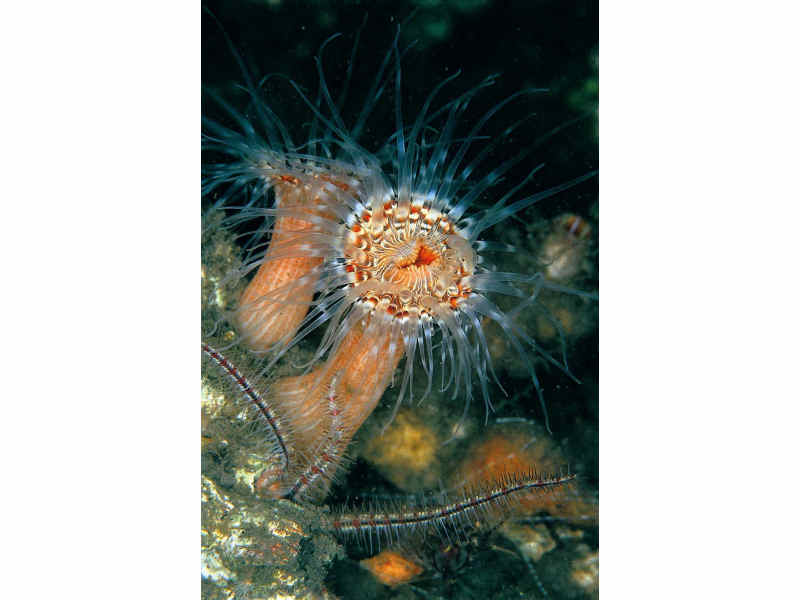Fountain anemone (Cylista lacerata)
Distribution data supplied by the Ocean Biodiversity Information System (OBIS). To interrogate UK data visit the NBN Atlas.Map Help
| Researched by | Sonia Rowley | Refereed by | Admin |
| Authority | (Dalyell, 1848) | ||
| Other common names | - | Synonyms | Sagartia coccinea Gosse 1858, Phellia picta Gosse 1858., Sagartiogeton laceratus (Dalyell, 1848) |
Summary
Description
Cylista lacerata is a small slender species up to 6 cm tall on expansion. The pillar-like column is wrinkled on contraction, smooth on expansion and flares out to the perfectly circular disc which has a diameter of up to 3 cm. The long graceful tentacles number up to 200 in total and are arranged irregularilly within 4-5 cycles. Each tentacle tapers to a fine point, are transluscent pale grey and possess 3 diffuse or white bands at the base, middle and tip (Manuel, 1988). At the base of each tentacle runs a pale v-shaped stripe, standing out from the brighter, darker orange markings of the disc. The column is a pale orange colour becoming pale buff-grey at the expanded base. The column also possess 12 cream verticle stripes, and numerous small dark spots (cinclides) in an irregular ring arrangement towards the distal end, just bellow the margin. A loose covering of mucus and sediment may also be present at the lower part of the column. There are no suckers present on this species.
Recorded distribution in Britain and Ireland
Sagartiogeton laceratus has been recorded on the western coasts of Britain and Ireland. This species may be under recorded.Global distribution
-Habitat
Sagartiogeton laceratus is a sublittoral species recorded to 100m deep and often found in more sheltered locations. It may occur in small groups formed from one individual due to its basal laceration. This species can be found attached to shells (Turritella spp.), worm tubes or stones, and occasionally buried partially in sand or mud.Depth range
-Identifying features
- Slender column up to 6 cm tall.
- Disc and Base up to 3 cm diameter.
- Up to 200 long, slender tentacles.
- Pale orange column with cream verticle stripes.
- Suckers absent.
Additional information
The taxonomy of the family Sagartiidae was recently examined by Sanamyan & Sanamyan (2020) who concluded that the genus Sagartia was not valid and should be assigned to the genus Cylista. Cylista lacerata reproduces asexually by constant pedal laceration (hence its name). A part of the base is lacerated to form a new individual, thus explaining the irregular shape of the base and irregular arrangement of tentacles and cinclides. The acontia (long stinging threads) are less readilly emitted from the cinclides than in other Sagartiid species. Cylista lacerata may be mistaken with Sagartiogeton undulatus, the former being smaller in size, brighter in colour with irregular, untidy tentacles that have no dark line running down them. Cylista lacerata can tolerate salinities up to 53.84 ppm (Stephenson, 1935).
Listed by
- none -
Bibliography
Gibson, R., Hextall, B. & Rogers, A., 2001. Photographic guide to the sea and seashore life of Britain and north-west Europe. Oxford: Oxford University Press.
Hayward, P., Nelson-Smith, T. & Shields, C. 1996. Collins pocket guide. Sea shore of Britain and northern Europe. London: HarperCollins.
Hayward, P.J. & Ryland, J.S. (ed.) 1995b. Handbook of the marine fauna of North-West Europe. Oxford: Oxford University Press.
Howson, C.M. & Picton, B.E., 1997. The species directory of the marine fauna and flora of the British Isles and surrounding seas. Belfast: Ulster Museum. [Ulster Museum publication, no. 276.]
JNCC (Joint Nature Conservation Committee), 1999. Marine Environment Resource Mapping And Information Database (MERMAID): Marine Nature Conservation Review Survey Database. [on-line] http://www.jncc.gov.uk/mermaid
Manuel, R.L., 1988. British Anthozoa. Synopses of the British Fauna (New Series) (ed. D.M. Kermack & R.S.K. Barnes). The Linnean Society of London [Synopses of the British Fauna No. 18.]. DOI https://doi.org/10.1002/iroh.19810660505
Naylor. P., 2005. Great British Marine Animals, 2nd Edition. Plymouth. Sound Diving Publications.
Picton, B.E., & Costello, M.J., 2001. BioMar biotope viewer: a guide to marine habitats and fauna of Britain and Ireland. http://www.itsligo.ie/biomar/echinode/ECHSEP.HTM, 2001-06-01
Sanamyan, K. & Sanamyan, N., 2020. Comments on the nomenclatural status and validity of several family-series nomina in Actiniaria (Cnidaria, Anthozoa). Bionomina, 19 (1), 100-109. DOI https://doi.org/10.11646/bionomina.19.1.6
Stephenson, T.A., 1935. The British Sea Anemones, vol. 2. London: Ray Society.
Wood. C., 2005. Seasearch guide to sea anemones and corals of Britain and Ireland. Ross-on-Wye: Marine Conservation Society.
Datasets
Centre for Environmental Data and Recording, 2018. Ulster Museum Marine Surveys of Northern Ireland Coastal Waters. Occurrence dataset https://www.nmni.com/CEDaR/CEDaR-Centre-for-Environmental-Data-and-Recording.aspx accessed via NBNAtlas.org on 2018-09-25.
Isle of Wight Local Records Centre, 2017. IOW Natural History & Archaeological Society Marine Invertebrate Records 1853- 2011. Occurrence dataset: https://doi.org/10.15468/d9amhg accessed via GBIF.org on 2018-09-27.
Kent Wildlife Trust, 2018. Kent Wildlife Trust Shoresearch Intertidal Survey 2004 onwards. Occurrence dataset: https://www.kentwildlifetrust.org.uk/ accessed via NBNAtlas.org on 2018-10-01.
NBN (National Biodiversity Network) Atlas. Available from: https://www.nbnatlas.org.
OBIS (Ocean Biodiversity Information System), 2025. Global map of species distribution using gridded data. Available from: Ocean Biogeographic Information System. www.iobis.org. Accessed: 2025-08-08
Citation
This review can be cited as:
Last Updated: 13/08/2007



